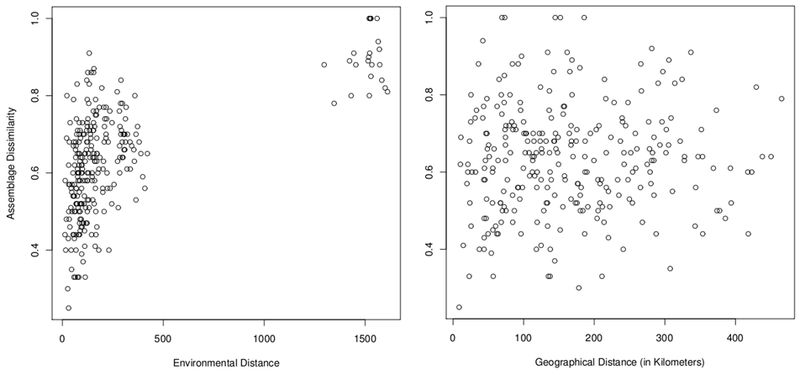1 Energy & Wetlands Research Group, Centre for Ecological Sciences, Indian Institute of Science, Bangalore – 560 012, India
2 Department of Botany, Yuvaraja’s College, Mysore - 570 005, India
E-mail: karthick@ces.iisc.ac.in, maheshkapanaiah@yahoo.co.in, cestvr@ces.iisc.ac.in
- Abstract
- Introduction
- Materials and Methods
- Results
- Discussion
- Conclusion
- Acknowledgement
- References
- Home
Results
The present investigation reports 98 taxa from the streams of Central Western Ghats region. The communities show highly significant nested pattern (T = 16.41°C p = 4.43e-31, matrix fill 14%) and mean T = 50.61(±2.88) °C derived from 1000 randomized matrices (Figure 2). The matrix consists of more of nested species (66%). Highly nested species in this dataset includes Gomphonema gandhii Karthick and Kociolek, Navicula rostellata Kützing, Surirella sp., Nitzschia reversa W. Smith, Nitzschia sigma (Kützing) W. Smith, Navicula viridula (Kützing) Kützing, Eunotia bilunaris (Ehrenberg) Souza in Souza & Moreira-Filho, Caloneis silicula (Ehrenberg) Cleveand Pinnularia acrosphaeria (Brébisson) W. Smith. Highly idiosyncraticspecies in this dataset are Gomphonema sp., Achnanthidium minutissimum (Kützing) Czarnecki, Nitzschia palea (Kützing) W. Smith, Brachysira neoexilis Lange-Bertalot, Planothidium frequentissimum Lange-Bertalot and Planothidium sp. In comparison to the nested species, idiosyncratic species are with wide ecological tolerance and cosmopolitan in distribution; in particular species like N. palea are known to present even in highly eutrophic water. Species such as A. minutissimum are known to occur only in oligotrophic water. Highly nested species in this dataset are probably endemic taxa (G. gandhii and Surirella sp.), apart from some cosmopolitan species.

Figure 2: Species distribution matrix in 24 streams in Central Western Ghats. The line indicates the maximally cold matrix.
The Mantel test of matrix revealed a strong relationship (p = 0.001) between species assemblages and environmental condition at sites, which are physical and chemical properties of the water. There is no significant relationship in the species assemblage or the environmental condition with geographical distance. Moreover the relationship of species assemblages with environmental condition was highly significant (p = 0.002) keeping geographical distance as constant in partial Mantel test. However, the species assemblages were not significantly correlated with geographical distance with environmental condition as constant (Figure 3). In other words, the closer localities did not have similar diatom species assemblages when compared to the more distant ones (Table 1).

Figure 3: Relation of species assemblage dissimilarity with the environmental and geographic distances
Table 1: Results of Mantel and partial Mantel tests for the relationship between species assemblage dissimilarity with environmental and geographical distance in diatoms sampled at 24 stream sites in Central Western Ghats. p-values were obtained by 1000 Monte Carlo permutations.
| Relations | r | p |
| Species composition and geographic distance | 0.05 | 0.28 |
| Species composition and environmental distance | 0.61 | 0.001 |
| Geographic distance and environmental distance | -0.05 | 0.53 |
| Species composition and geographic distance with environmental distance effect controlled | 0.11 | 0.08 |
| Species composition and environmental distance with geographic distance effect controlled | 0.62 | 0.002 |
According to PCA analysis, the first, second and third principal axis captured 57.8%, 11.2% and 9.05% variance respectively (Table 2). PCA indicated that environmental conditions differed markedly across the sampling sites with the first three components explaining 78% of variance. PC1 represents the increase in ionic characters like electrical conductivity, alkalinity, chlorides, calcium, sodium and potassium, while PC2 reflected an increase in magnesium, phosphates and nitrates and decrease in dissolved oxygen.
Table 2: Stream water chemistry based principal components reflecting major water quality gradients, significant variables in 24 stream sites in the Central Western Ghats.
| Principal Components | PC1 | PC2 | PC3 |
| % Variance | 57.8 | 11.2 | 9.05 |
| Significant positive correlation | Electrical Conductivity (0.33), Alkalinity (0.34), Chlorides (0.33), Calcium (0.34), Sodium (0.33), Potassium (0.33) | Magnesium (0.38), Phosphates (0.63), Nitrates (0.51) | pH (0.44), Water Temperature (0.55) |
| Significant negative correlation | Dissolved Oxygen (-0.37) | Sulphates (-0.37) |
| * Corresponding Author : | |||
| Dr. T.V. Ramachandra Energy & Wetlands Research Group, Centre for Ecological Sciences, Indian Institute of Science, Bangalore – 560 012, INDIA. Tel : 91-80-23600985 / 22932506 / 22933099, Fax : 91-80-23601428 / 23600085 / 23600683 [CES-TVR] E-mail : cestvr@ces.iisc.ac.in, energy@ces.iisc.ac.in, Web : http://wgbis.ces.iisc.ac.in/energy |
|||

